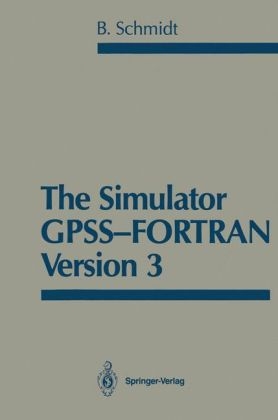
The Simulator GPSS-FORTRAN Version 3
Springer-Verlag New York Inc.
978-0-387-96504-8 (ISBN)
- Titel ist leider vergriffen;
keine Neuauflage - Artikel merken
0. Introduction.- 0.1 The Structure of the Simulator GPSS-FORTRAN Version 3.- 0.1.1 The Program Package.- 0.1.2 Modular Structure and Structured Programming.- 0.2 Modelling.- 0.2.1 Queuing Models.- 0.2.2 Event Oriented Simulation.- 0.2.3 Simulation of Continuous Systems.- 0.2.4 Combined Models.- 0.3 Ease of Use.- 0.3.1 The Documentation.- 0.3.2 Model Construction.- 0.3.3 The Input and Output.- 0.3.4 The Operational Modes.- 0.3.5 The Size of the Simulator.- 0.3.6 Possible Environments of the Simulator GPSS-FORTRAN Version 3.- 0.3.7 How to Learn the Use of GPSS-FORTRAN Version 3.- 0.4 Acknowledgements.- 1. The Flow Control.- 1.1 Model Classification.- 1.2 State Transitions.- 1.2.1 Scheduled State Transitions.- 1.2.2 Conditional State Transitions.- 1.3 The Subroutine FLOWC.- 1.3.1 The Schedules of the State Transitions.- 1.3.2 The Subroutines for the State Transitions.- 1.3.3 The Flow Chart of the Subroutine FLOWC.- 1.3.4 The Structure of the Simulator.- 1.4 Simultaneous Activities.- 1.4.1 The Processing Sequence for Simultaneous Activities.- 1.4.2 The Discriminator EPS.- 2. The Simulation of Continuous Systems.- 2.1 Differential Equations in GPSS-FORTRAN Version 3.- 2.1.1 The Formulation of the Differential Equations.- 2.1.2 Sets.- 2.1.3 Numerical Integration.- 2.2 Scheduled State Transitions.- 2.2.1 The Data Areas and the Calling Sequence.- 2.2.2 Treatment of Time.- 2.2.3 The Initial State and Scheduled Events.- 2.2.4 The Monitor.- 2.2.5 An Example of a Model.- 2.2.6 Delays.- 2.3 Conditional State Transitions.- 2.3.1 Crossings and the Flag Variables IFLAG and JFLAG.- 2.3.2 Crossings and Sets.- 2.3.3 The Conditions and Their Checking.- 2.4 The Subroutine EQUAT.- 2.4.1 Performance of an Integration Step.- 2.4.2 Localising the Crossing.- 2.4.3 The Remaining Operations of EQUAT.- 2.4.4 Discontinuity of Delayed Variables.- 2.5 Adding to or Removing from a Chain Using TCHAIN andNCHAIN.- 2.6 Integration Methods.- 2.6.1 The Subroutine INTEG.- 2.6.2 Subroutines Containing the Integration Methods.- 3. Queued Models.- 3.1 Transactions.- 3.1.1 Data Areas for Transactions.- 3.1.2 Transaction States.- 3.1.3 Stations.- 3.1.4 Transaction Control.- 3.1.5 The Subroutines DBLOCK and RBLOCK.- 3.1.6 Queue Management and Policy.- 3.2 Subroutines for Processing Transactions.- 3.2.1 Subroutines for Generating and Eliminating Transactions.- 3.2.2 Deactivation of Transactions for Known Length of Time.- 3.2.3 Subroutines for Gates.- 3.2.4 Transfer of Transactions.- 3.2.5 Combined Models.- 3.3 An Example of a Model.- 3.3.1 Description of Model.- 3.3.2 The Sequence of Activities.- 3.3.3 The Blocked Transactions.- 4. Stations and Queued Models.- 4.1 Facilities.- 4.1.1 SEIZE.- 4.1.2 WORK.- 4.1.3 CLEAR.- 4.1.4 PREEMP.- 4.1.5 Setting Up and Closing Down Times at Preemption.- 4.1.6 Occupation of a Facility in Parallel Processing Paths.- 4.1.7 The Blocking Indicator.- 4.2 Multifacilities.- 4.2.1 The Structure of the Multifacilities.- 4.2.2 Occupation, Processing, and Freeing.- 4.2.3 Preemption in Multifacilities.- 4.2.4 The Plan for Freeing and Occupying Individual Elements.- 4.3 Pools and Storages.- 4.3.1 Pools.- 4.3.2 Structure of the Storages.- 4.3.3 The Occupying and Freeing of Storages.- 4.3.4 Strategies.- 4.4 Coordination in Processing Paths.- 4.4.1 Coordination in a Processing Path.- 4.4.2 Coordination of Parallel Processing Paths.- 4.5 Families.- 4.5.1 The Grouping Together of Transactions.- 4.5.2 Generation and Elimination of Members of a Family.- 4.5.3 The Coordination of Family Members in a Single Path.- 4.5.4 The Coordination of Family Members in Parallel Paths.- 4.6 Match Stations.- 5. Evaluation and Representation of the Results.- 5.1 The Behaviour of the Queues.- 5.1.1 Bins.- 5.1.2 Characteristic Quantities of a Bin.- 5.1.3 Calculation of the Mean Values.- 5.1.4 Mean Values for Intervals.- 5.1.5 The Subprogram ENDBIN.- 5.1.6 The Computation of the Confidence Interval and the End of the Settling Phase.- 5.2 The Computation of Frequency Tables.- 5.3 Output of the State of the Model.- 5.3.1 The Report Subroutines.- 5.3.2 The Trace Indicators IPRINT and JPRINT.- 5.4 Auxiliary Aids.- 5.4.1 Initialisation of the Data Areas.- 5.4.2 Saving and Reinputting the State of the System.- 5.4.3 Ending the Simulation Run.- 5.4.4 The Subroutine FUNCT.- 6. The Generation of Random Numbers.- 6.1 Generators of Random Numbers.- 6.2 Generation of Uniformly Distributed Random Numbers.- 6.3 Generation of Random Numbers with an Arbitrary Distribution.- 6.3.1 Generation of Random Numbers Using Inverse Functions.- 6.3.2 The Erlang Distribution.- 6.3.3 The Gaussian Distribution.- 6.3.4 The Logarithmic Gaussian Distribution.- 6.3.5 Approximation of Empirically Determined Distribution.- 6.3.6 The Truncation of the Frequency Function.- 6.4 Random Numbers in GPSS-FORTRAN Version 3.- 6.4.1 The Function RN.- 6.4.2 UNIFRM.- 6.4.3 ERLANG.- 6.4.4 GAUSS.- 6.4.5 LOGNOR.- 6.4.6 BOXEXP.- 6.4.7 Notes.- 7. Input and Output.- 7.1 Free Format Input.- 7.1.1 The Input Data Records.- 7.1.2 The Subroutine INPUT.- 7.1.3 The Input of Variables using a VARI Data Record.- 7.2 Output of Plots.- 7.2.1 The Recording of the Plot Data.- 7.2.2 The Plot Arrays.- 7.2.3 The Subroutine PLOT.- 7.3 Output of Bar Charts Using GRAPH.- 7.4 Operational Modes.- 7.4.1 Real Time Operation.- 7.4.2 Interactive Mode.- 7.4.3 Interactive Commands.- 7.5 Graphic Representation.- 7.5.1 Commands in Interactive Mode with Graphics.- 7.5.2 Menu for the Z Command.- 7.5.3 The Second Level of the Menu Hierarchy.- 7.5.4 The Third Level of the Menu Hierarchy.- References.
| Zusatzinfo | biography |
|---|---|
| Verlagsort | New York, NY |
| Sprache | englisch |
| Gewicht | 640 g |
| Themenwelt | Informatik ► Grafik / Design ► Digitale Bildverarbeitung |
| Mathematik / Informatik ► Informatik ► Programmiersprachen / -werkzeuge | |
| Mathematik / Informatik ► Informatik ► Theorie / Studium | |
| ISBN-10 | 0-387-96504-1 / 0387965041 |
| ISBN-13 | 978-0-387-96504-8 / 9780387965048 |
| Zustand | Neuware |
| Informationen gemäß Produktsicherheitsverordnung (GPSR) | |
| Haben Sie eine Frage zum Produkt? |
aus dem Bereich


